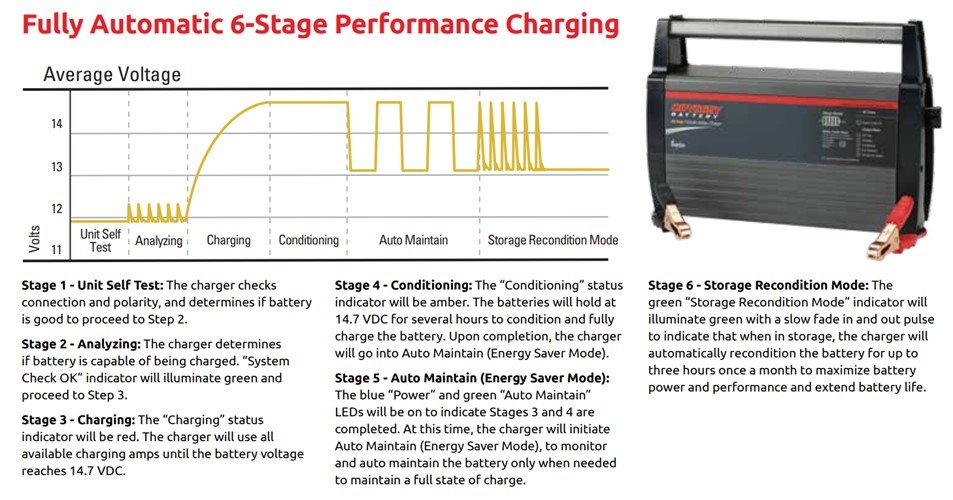Well if your talking a lead battery then I think any charger will do even a 40 year old one. However battery's have a "preferred" methodology to charging them based on chemical composition.
AMP output at specific voltages makes or breaks a charger/battery.
Recently spent some time on the phone with a Yuasa tech. Scott is a great guy. I was asking about fitment of battery's for my 2017 GS. As stock is like 4 3/8" high their battery's are over 5". So to that there seems there is a spacer below the battery which allows a much taller(more plates) battery to be installed from the factory mini.
So I asked him about charging and maintaining. He is right down the road from me as the battery's are made in Reading, PA. Turns out he used to own a motorcycle shop and very familiar with Hermys as a client and friend. and is my dealer. Any way I asked do you keep your bikes on a charger and he said no. He said he will plug it in if he cant get a ride in over a few weeks in winter which here in PA we can ride a bit in winter. I asked why and he said that if the battery is used every few weeks and run over 2500 RPMs for a period of time that is all the battery needs. He says he does not maintain but rather once it completes a cycle of test, charge, and then into maintain mode, he unplugs it. Rinse and repeat as needed.
I have zero personal experience with LI but had a friend who had one and it was a PITA here in PA in the winter. He had to turn his bike on without starting and excite the battery, then turn the bike off, and then turn it back on and go for a start. He had a bit of money invested in the LI battery and specific charger.
I encourage anyone to look at battery chargers and their features to match them to the class of battery you are using. Again and battery's improve the techniques to maintain them and the science behind that is very relevant to your charger/battery match.
Me, I use Yuasa battery's as they are hometown for me made right down the road in the USA, and a Optimate charger. The Optimate runs a test cycle shooting varying amount of voltage into the battery to see if it can accept a charge. After that test it goes to charge. and then finally to maintain. I have seen 14.7 being shot into it while watching it run a test cycle but I did not stay on it too long as it takes a good bit of time for it to run the test cycle depending on the battery condition.
Use the right charger for the right battery. And not all chargers are created equal.
AMP output at specific voltages makes or breaks a charger/battery.
Recently spent some time on the phone with a Yuasa tech. Scott is a great guy. I was asking about fitment of battery's for my 2017 GS. As stock is like 4 3/8" high their battery's are over 5". So to that there seems there is a spacer below the battery which allows a much taller(more plates) battery to be installed from the factory mini.
So I asked him about charging and maintaining. He is right down the road from me as the battery's are made in Reading, PA. Turns out he used to own a motorcycle shop and very familiar with Hermys as a client and friend. and is my dealer. Any way I asked do you keep your bikes on a charger and he said no. He said he will plug it in if he cant get a ride in over a few weeks in winter which here in PA we can ride a bit in winter. I asked why and he said that if the battery is used every few weeks and run over 2500 RPMs for a period of time that is all the battery needs. He says he does not maintain but rather once it completes a cycle of test, charge, and then into maintain mode, he unplugs it. Rinse and repeat as needed.
I have zero personal experience with LI but had a friend who had one and it was a PITA here in PA in the winter. He had to turn his bike on without starting and excite the battery, then turn the bike off, and then turn it back on and go for a start. He had a bit of money invested in the LI battery and specific charger.
I encourage anyone to look at battery chargers and their features to match them to the class of battery you are using. Again and battery's improve the techniques to maintain them and the science behind that is very relevant to your charger/battery match.
Me, I use Yuasa battery's as they are hometown for me made right down the road in the USA, and a Optimate charger. The Optimate runs a test cycle shooting varying amount of voltage into the battery to see if it can accept a charge. After that test it goes to charge. and then finally to maintain. I have seen 14.7 being shot into it while watching it run a test cycle but I did not stay on it too long as it takes a good bit of time for it to run the test cycle depending on the battery condition.
Use the right charger for the right battery. And not all chargers are created equal.



